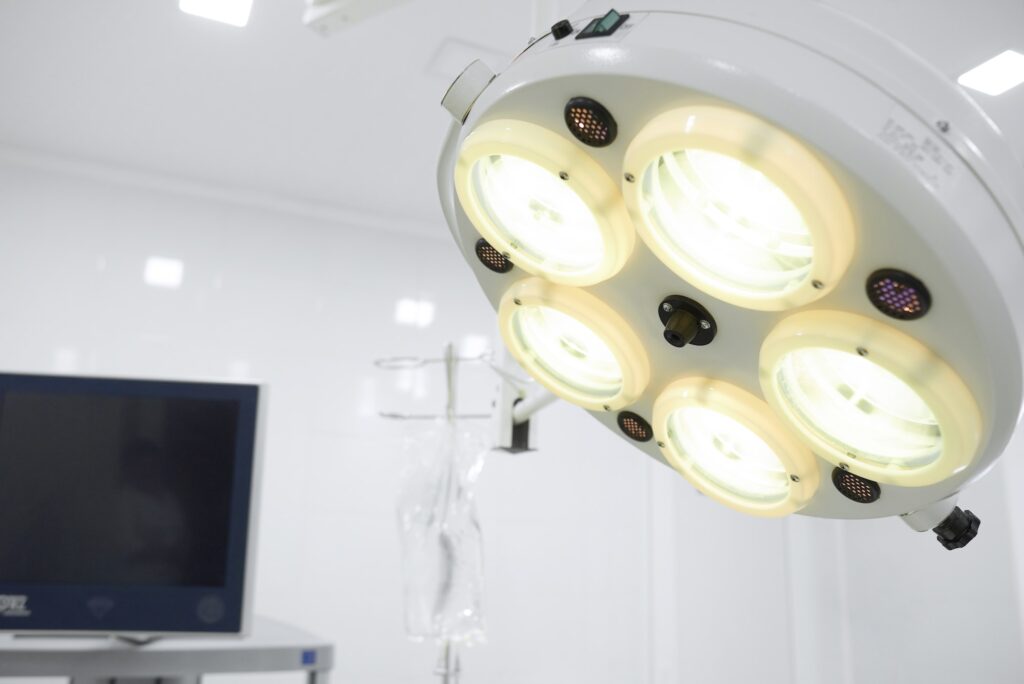For many of the female cancers such as cervical cancer, endometrial cancer, vaginal cancer, vulvar cancer, ovarian and fallopian tube cancer, the radiation treatments given will include both external beam radiation therapy using a linear accelerator, and internal radiation called brachytherapy. The external radiation is used to deliver a dose of radiation to a larger area in the body. It gives a nice uniform dose over that area which frequently includes the tumor and draining lymph nodes. Internal radiation is given using a device called HDR–high dose rate brachytherapy. These HDR treatments that are often referred to as “implants” involve placing an apparatus inside the body very close to the cancer, and loading radiation into that apparatus and delivering a high dose of radiation over a short period of time. This is usually done for several doses or fractions ranging usually from 1-6 in number. Internal radiation is used when a dose of radiation needs to be delivered to a small area, by placing the radiation as close as possible to the cancer cells. That allows for a dose of radiation to be delivered to the cancer while the normal near-by organs get a very low dose. At Genesis, we have the most active brachytherapy practice in San Diego County, and our physicians are well trained in this very important aspect of radiation therapy.
When HDR treatments are given, many of our staff will be directly involved with your care: a nurse to provide intravenous medication, comfort control, and assistance with placement of the implant; a member of the physics department to determine how the radiation dose can be delivered properly so that the cancer gets the maximum dose of radiation while normal organs are sparred a dose of radiation as much is as possible; a therapist to provide x-rays for dose determination; and the physician to accurately place the implant and determine a treatment plan. In addition these treatments must be given in suite that has been specially shielded for this purpose. For these reasons we have centralized the delivery of these HDR treatments at our Laurel office.
SIDE EFFECTS OF RADIATION THERAPY FOR GYNECOLOGIC CANCERS
The following are the most common side effects, both acute and chronic, resulting from radiation. Unforeseen side effects may occur because of the unique and varied tolerance of individual persons. Late effects of treatment may not always be predictable and may be influenced by concurrent and/or subsequent treatment for this and other diseases. These common side effects include, but may not be limited to the following.
Radiation treatment of the pelvis for gynecologic malignancies usually entails approximately 5 to 6 weeks of daily treatment, given Monday through Friday. In addition, implanted radiation might be a part of your treatment plan. The pelvic area that is treated includes many structures which, when irradiated, usually result in reactions during the course of treatment and for several weeks following.
Fatigue is a common side effect and usually appears at about the third week of treatment. It is a cumulative side effect so that it usually increases as the treatments continue. It takes approximately 4 to 6 weeks after treatment for the fatigue to subside. This is not normally debilitating and, in itself, should not affect your daily activities or ability to drive. However, you may wish to go to bed earlier or take an afternoon nap during this period. Fatigue and weakness are worse in patients who lose weight. Accordingly, we strongly encourage you to supplement your diet with high calorie foods or commercially available nutritional supplements (for example Ensure Plus, Sustacal, Boost), if necessary to maintain your weight.
Your blood counts may require monitoring periodically during treatment, especially if you also receive chemotherapy.
The skin within the area treated usually becomes pink, much like a sunburn, and there may be some loss of pubic hair. The reaction is usually accentuated in the buttocks region and around the anus where enlargement of hemorrhoids may become a painful problem. Stools may become more frequent with diarrhea often becoming a problem, with occasional passage of mucous and blood. This is generally a reaction that occurs during the latter part of treatment. The bladder may also become irritated by radiation treatments and this may result in frequent and/or painful urination. Vaginal irritation may occur to variable degrees.
In rare cases, a more radical approach called total abdominopelvic radiation therapy is used for patients with gynecologic malignancies. In addition to all of the side effects described above, total abdominopelvic radiation therapy usually adds nausea with or without vomiting, a more severe case of diarrhea, increased fatigue, and low blood counts. Your physician and staff will work hard to help you to overcome these effects.
Most of the above-described symptoms may be treated by local measures or oral medications, which your physician may prescribe. Many of the bowel symptoms may be alleviated by a change in diet. Your physician and staff will help in selecting the appropriate measures when these symptoms occur. Side effects of treatment will usually subside within several weeks but, in a few patients, may persist for months. Much less commonly, less than 5% of the time, difficulties with the intestine, bladder, vagina, or rectal area may yield long-term side effects such as bleeding, obstruction or fistulization (a hole) in the bowel. These may require surgical repair or colostomy. Fortunately, complications of this severity are rare.
You may also notice permanent subtle changes in the treated area including the skin. Inexpensive moisturizing lotion or aloe vera gel is recommended for local dryness or itchiness. The treated skin may be more sensitive to sun exposure. Accordingly, we advise wearing clothing or sunscreen over the treated area while spending time outdoors. This is a lifelong recommendation. If the vagina was treated with implant radiation, it may become narrowed over time. This complication is usually preventable with simple, regular vaginal dilation techniques.
This statement is not a warranty, but it is simply meant to give information regarding typical radiotherapy side effects and their management. Catastrophic or even fatal radiation complications may occur in rare cases. Great care will be taken to minimize the side effects and reduce the risk of radiation damage to normal tissues.



